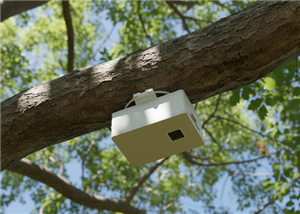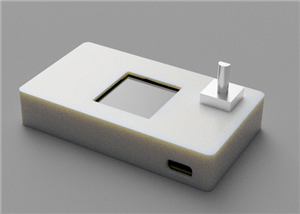|
|
ATTINY85-20SU |
x 1 | |
|
|
18mm Piezo/Buzzer/Beeper |
x 1 | |
|
|
BMP280 |
x 1 | |
|
|
slide-switch |
x 1 |

|
arduino IDEArduino
|
|

|
Soldering Iron Kit |
Altitude Indicator with Beeper for Rocketry
Altitude Indicator for Model Rocketry
In our ever-advancing technological landscape, countless projects employ diverse components to amass, process, and visually represent data for a myriad of applications. This innovative device, known as the Altitude Indicator, serves as a sturdy, adaptable platform for model rocket enthusiasts. It employs an ATTiny85 microcontroller, a BMP280 sensor for measuring altitude, and a simple buzzer connected to pin 6.
Disclaimer:
Please note that this Altitude Indicator has been designed specifically for model rocketry. The data displayed by the buzzer in the form of distinct beeps corresponds to the maximum altitude reached by the rocket, as measured by the BMP280 sensor. For the Indicator to function properly, it must be incorporated into the rocket's structure, and it is vital to protect the device from intense heat and vibration associated with the rocket's launch and descent.
Potential Applications:
- Model Rocketry: The primary application of the Altitude Indicator is in model rocketry. By collecting data from the BMP280 sensor and transforming it into a series of beeps, the device offers a unique way for enthusiasts to determine the maximum altitude reached by their rockets. Each beep signifies a digit from the altitude, with the amount of beeps indicating the digit itself.
- Portable Devices: Given its compact design and power efficiency, this Altitude Indicator can be utilized in a range of portable devices. Its potential isn't limited to model rocketry; one could easily adapt the concept for use in hiking equipment, portable weather devices, or any application requiring a simple, audibly indicated data representation.
- IoT and Hobbyist Devices: The small, modular design of this Altitude Indicator makes it an excellent candidate for various IoT and hobbyist projects, like DIY weather balloons, drones, or even amateur radiosondes.
Building Guide - Altitude Indicator:
- Gather the necessary tools and materials: You will need an ATTiny85 microcontroller, a BMP280 sensor, a buzzer, soldering iron, solder, flux, desoldering wick or pump, brass sponge or steel wool for cleaning the soldering iron tip, heat-resistant surface or soldering mat, and tweezers or small pliers for holding components.
- Prepare the PCB board: Clean the PCB board with isopropyl alcohol and a lint-free cloth to remove any dust or grease, ensuring proper solder adherence.
- Prepare the components: Inspect each component for any damage. If any pins are bent or if there are excessive leads, correct and trim them as needed.
- Insert the male pins into the components: For the ATTiny85 and the BMP280, gently insert the pins into the suitable holes. Make sure the pins are correctly aligned and securely inserted.
- Secure the components to the PCB: Place each component on the PCB, aligning the male pins with the corresponding solder pads or holes. Secure the components with masking tape, Blu-Tack, or a tiny amount of hot glue.
- Heat up the soldering iron: Switch on your soldering iron and let it reach the appropriate temperature (around 350°C or 650°F for 60/40 solder).
- Tin the soldering iron tip: Apply a small amount of solder to the iron tip to create a thin layer of molten solder. This process, known as "tinning," enhances heat transfer and simplifies the soldering process.
- Solder the components to the PCB: Hold the soldering iron in one hand and the solder in the other. Touch the iron tip to the junction of the component lead (or male pin) and the PCB pad. After a brief moment, introduce the solder to the joint. The solder should flow smoothly and create a shiny, concave fillet. Simultaneously remove the solder and the iron, allowing the joint to cool. Repeat for each component lead or pin.
- Inspect the solder joints: Use a magnifying glass or microscope to scrutinize the solder joints for any cold solder, bridges, or other defects. Cold solder joints appear dull or grainy and may result in poor connections. Bridges are undesired solder connections between adjacent pads or traces and may cause short circuits.
- Fix any issues: If you find any solder joint problems, use a desoldering wick or pump to remove the excess solder, clean the area, and try again. If a component is poorly aligned or damaged, carefully remove it, clean the area, and replace it with a new component.
- Clean the PCB: After successfully soldering all components, clean the PCB with isopropyl alcohol and a lint-free cloth to remove any residual flux.
- Test the assembled board: After the PCB has dried, power up the board and test its functionality. If the buzzer correctly indicates a series of beeps based on your inputs, congratulations! You've successfully assembled your custom Altitude Indicator.
- Programming the Board: Use the provided code snippets to test the Altitude Indicator. Make sure the device correctly measures altitude and translates it into a series of beeps. Customize the code to suit your specific needs or the specific needs of your model rocket.
Happy rocketing!
#include <Wire.h>
#include <Adafruit_Sensor.h>
#include <Adafruit_BMP280.h>
// Pin for the buzzer
#define BUZZER 6
Adafruit_BMP280 bmp; // I2C
double maxAltitude = -999999;
void setup() {
// Initialize sensor
if (!bmp.begin()) {
// Failed to initialize BMP280
// Indicate error state using the buzzer
tone(BUZZER, 1000, 2000);
while (1);
}
pinMode(BUZZER, OUTPUT);
}
void loop() {
double altitude = bmp.readAltitude();
if (altitude > maxAltitude) {
maxAltitude = altitude;
// Convert maxAltitude to a series of beeps and emit through buzzer
transmitAltitudeAsBeeps(maxAltitude);
// End beep
tone(BUZZER, 1000, 2000);
delay(3000); // delay before repeating the series
}
delay(100); // Delay between readings
}
void transmitAltitudeAsBeeps(double altitude) {
int integerPart = (int)altitude;
// Converting each digit of altitude to series of beeps
while (integerPart > 0) {
int digit = integerPart % 10;
for (int i = 0; i < digit; i++) {
// Emit beep
tone(BUZZER, 1000, 100);
delay(300); // delay between each beep in a digit
}
delay(1000); // delay between digits
integerPart /= 10;
}
}
Altitude Indicator with Beeper for Rocketry
*PCBWay community is a sharing platform. We are not responsible for any design issues and parameter issues (board thickness, surface finish, etc.) you choose.
- Comments(0)
- Likes(1)
-
 Inaki Iturriaga
Jul 15,2023
Inaki Iturriaga
Jul 15,2023
- 0 USER VOTES
- YOUR VOTE 0.00 0.00
- 1
- 2
- 3
- 4
- 5
- 6
- 7
- 8
- 9
- 10
- 1
- 2
- 3
- 4
- 5
- 6
- 7
- 8
- 9
- 10
- 1
- 2
- 3
- 4
- 5
- 6
- 7
- 8
- 9
- 10
- 1
- 2
- 3
- 4
- 5
- 6
- 7
- 8
- 9
- 10
 More by Inaki Iturriaga
More by Inaki Iturriaga
-
 Battery-Powered ESP32-CAM Continuous Video Recorder
OverviewThis project transforms an ESP32-CAM module into a standalone, battery-powered video recordi...
Battery-Powered ESP32-CAM Continuous Video Recorder
OverviewThis project transforms an ESP32-CAM module into a standalone, battery-powered video recordi...
-
 GPS Mobile Beacon
Building a GPS Emergency Beacon: A DIY TutorialWelcome to our latest DIY project: creating a GPS Eme...
GPS Mobile Beacon
Building a GPS Emergency Beacon: A DIY TutorialWelcome to our latest DIY project: creating a GPS Eme...
-
 Wireless RFID Card Copier.
Wireless RFID Card CopierIn today's digital world, security and accessibility are of paramount impor...
Wireless RFID Card Copier.
Wireless RFID Card CopierIn today's digital world, security and accessibility are of paramount impor...
-
 Piezo Alert System.
Within the fast-evolving sphere of security tools and home automation, creativity often paves the wa...
Piezo Alert System.
Within the fast-evolving sphere of security tools and home automation, creativity often paves the wa...
-
 Wifi Weather Station - Sensors board
WiFi Weather Station - Sensor unitIn our digital era, many electronics projects integrate diverse se...
Wifi Weather Station - Sensors board
WiFi Weather Station - Sensor unitIn our digital era, many electronics projects integrate diverse se...
-
 Building a GPS Speedometer with RP2040-Zero
Build a Feature-Packed GPS Speedometer with an RP2040This project guide will walk you through buildi...
Building a GPS Speedometer with RP2040-Zero
Build a Feature-Packed GPS Speedometer with an RP2040This project guide will walk you through buildi...
-
 RC Receiver
Build Your Own RC ReceiverHarnessing advanced electronics and precise control systems, the RC Receiv...
RC Receiver
Build Your Own RC ReceiverHarnessing advanced electronics and precise control systems, the RC Receiv...
-
 Universal RC Controller
Build Your Own Universal RC RemoteHarnessing the power of custom PCBs and wireless communication, th...
Universal RC Controller
Build Your Own Universal RC RemoteHarnessing the power of custom PCBs and wireless communication, th...
-
 Continuous GPS Tracker
This compact and efficient tracker provides real-time location updates, making it ideal for surveill...
Continuous GPS Tracker
This compact and efficient tracker provides real-time location updates, making it ideal for surveill...
-
 Air Quality Monitor
Welcome to our DIY tutorial on assembling an Air Quality Monitoring Device. This project is perfect ...
Air Quality Monitor
Welcome to our DIY tutorial on assembling an Air Quality Monitoring Device. This project is perfect ...
-
 Automatic Watch Winder
Automatic Watch WinderIn the realm of luxury timepieces and watch aficionados, an automatic watch is...
Automatic Watch Winder
Automatic Watch WinderIn the realm of luxury timepieces and watch aficionados, an automatic watch is...
-
 Handheld GPS
Within the swiftly advancing realm of portable technology and travel essentials, innovation often sh...
Handheld GPS
Within the swiftly advancing realm of portable technology and travel essentials, innovation often sh...
-
 Dual Motor Controller for Model Robotics
In the thrilling world of robotics and DIY engineering, innovation continues to soar to new heights....
Dual Motor Controller for Model Robotics
In the thrilling world of robotics and DIY engineering, innovation continues to soar to new heights....
-
 Altitude Indicator with Beeper for Rocketry
Altitude Indicator for Model RocketryIn our ever-advancing technological landscape, countless projec...
Altitude Indicator with Beeper for Rocketry
Altitude Indicator for Model RocketryIn our ever-advancing technological landscape, countless projec...
-
 Wifi Weather Station - Display unit
WiFi Weather Station - Display UnitIn this technologically advanced age, countless electronics proje...
Wifi Weather Station - Display unit
WiFi Weather Station - Display UnitIn this technologically advanced age, countless electronics proje...
-
 Positon Breakout Board
Position Sensors Breakout Board In today's era of advanced technology, many electronics projects req...
Positon Breakout Board
Position Sensors Breakout Board In today's era of advanced technology, many electronics projects req...
-
 Ambient Sensors Breakout Board
In today's world, electronics projects often require the integration of multiple sensors to collect ...
Ambient Sensors Breakout Board
In today's world, electronics projects often require the integration of multiple sensors to collect ...
-
 Infrared Launch Controller
IntroductionHave you ever wanted to remotely launch a rocket, drone or other device using infrared t...
Infrared Launch Controller
IntroductionHave you ever wanted to remotely launch a rocket, drone or other device using infrared t...
-
-
mammoth-3D SLM Voron Toolhead – Manual Drill & Tap Edition
88 0 0 -
-
AEL-2011 Power Supply Module
602 0 2 -
AEL-2011 50W Power Amplifier
542 0 2 -
-
-
Custom Mechanical Keyboard
746 0 0 -
Tester for Touch Screen Digitizer without using microcontroller
371 2 2 -
Audio reactive glow LED wristband/bracelet with NFC / RFID-Tags
346 0 1 -
-














































